The Weekly Anthropocene Interviews: Dr. Daniel Kinka of American Prairie
A Scientist Spotlight Interview
Dr. Daniel Kinka is the Senior Wildlife Restoration Manager at American Prairie. This NGO is buying, leasing, and rewilding private and federal land in eastern Montana to create the largest wildlife refuge in the lower 48 states, a growing “American Serengeti” where bison are free to resume their wild grazing patterns and the ancient ecosystem of the northern Great Plains can be reborn.
A lightly edited transcript of this exclusive interview follows. This writer’s questions and remarks are in bold, Dr. Kinka’s responses are in regular type. Bold italics are clarifications and extra information added after the interview.
How did you come to be the Senior Wildlife Restoration Manager at the American Prairie Reserve?
I guess the short answer is I started as the wildlife restoration manager and got promoted to the senior wildlife restoration manager [laughs].
I did a couple degrees in psychology, and decided to switch to my other passion, which has always been ecology and wildlife biology. In 2010, I accepted a couple jobs in Grand Teton National Park. I spent a few years there doing fieldwork, and then went back to school at Utah State University to get my Ph.D. in ecology. I was fortunate that right as I was coming out of graduate school, this job at American Prairie had come up. It sounded like a really nice marriage of all of my interests and qualifications. I didn’t want to be in academia anymore, I wanted to be putting ecological research to work from a restoration perspective. That was much more interesting to me, and there are not a lot of jobs like that, unfortunately. I started at American Prairie January of 2018, weeks after I defended my dissertation. That’s how you get to be a senior wildlife restoration manager, I suppose.
How would you describe the mission of American Prairie?
The mission of American Prairie is to create the largest wildlife refuge in the lower 48 states. In a place [eastern Montana] that is still largely intact from a habitat perspective, but is missing a lot of its wildlife species. And in terms of traditional land usage, a lot of this land is private land and not accessible to the general public. American Prairie, when we can, purchases ranches that are for sale and converts them from ranches to biodiversity projects. When we can, we swap out cattle for bison, and we invite the general public to come and visit. So we’re unlocking public lands and private lands to rewild these lands.
From my perspective, my job as the wildlife restoration manager is to oversee our rewilding activities. We’ve recently come out with a rewilding plan that should take us five years into the future, and then we will revisit that again going forward.
Rewilding is this idea that going forward in a modern context, without turning back the clock, alongside modern people living modern lives, we can put back a lot of the biodiversity that this place had as recently as two hundred years ago. Most of the species that called this place home still call this place home but in very, very low abundance, relative to what used to be here. There’s a couple missing species, but for the most part you don’t have to look too far to find the missing species. They’re in nearby mountain ranges, or something similar. So the project is not so much about species diversity as species abundance.
There’s just way too little of everything. Bison really only exist behind fences as livestock, and those are only the ones that we put back there. Wolves and grizzly bears are absent from the system. Black-footed ferrets and swift foxes exist in vanishingly small populations if at all. Elk and pronghorn and bighorn sheep exist, but in very low abundance relative to what Lewis and Clark would have seen, and what indigenous peoples for tens of thousands of years prior to that. Grassland birds exist out here, but they have seen some of the steepest declines of any North American bird. Everything’s here, for the most part, there’s just way too little of it. And for some species, they’re rapidly declining even further.
So rewilding at American Prairie is about turning the volume back up on wildlife abundance. Not necessarily reintroducing species, we don’t even have to do that in many cases. How do we get more of everything? Because we know that more of everything is what the ecosystem depends on, to be resilient, to be fully functional, to provide ecosystem services like drought mitigation and carbon storage that it should do if it’s fully functional.
That’s what rewilding means for us. It’s not de-extinction rewilding, it’s just more bison, more elk, a couple grizzly bears, a handful of wolves, swift foxes, black-footed ferrets, a lot more prairie dogs, long-billed curlews and sage grouse, et cetera, et cetera. So if you came out to American Prairie, you would not only see the vast, beautiful expanses of prairie that exist today, but giant herds of migrating wildlife, like bison, like pronghorn, moving across the landscape, in the way they would have as recently as 150 years ago.
“If you came out to American Prairie, you would not only see the vast, beautiful expanses of prairie that exist today, but giant herds of migrating wildlife, like bison, like pronghorn, moving across the landscape in the way they would have as recently as 150 years ago.”
-Dr. Daniel Kinka
Well, that is awesome! That is incredibly cool. As an ecologist, can you break down for me what reintroducing bison does to the landscape? If land has been grazed by cattle for a hundred and fifty years, what happens when you bring back bison? I know they do a lot of things, they graze differently, they create wallows.
That’s a great question with a very long answer. Bison are, in addition to being the national mammal, what we call a keystone species themselves-ecosystem engineers, for a more specific term. We have three ecosystem engineers here, bison, black-tailed prairie dogs, and beaver, but let’s just talk about bison. What do bison do when they are rewilded?
So American Prairie buys a property, and we do that all the time. There are bison outside my window right now, I can see them. This property became an American Prairie property in about 2004, 2005, and we reintroduced bison shortly thereafter. The cattle that were here when we bought it went with the original owner, and we brought back bison as soon as we could. What does that do? Well, one of the primary differences between bison and European domestic cattle is that bison are much more adapted to the dry, arid environment of shortgrass prairie. They’re very, very heat-tolerant. And cold-tolerant, but very heat-tolerant.
They’re a climate-resilient ungulate, you might say.
Very much. This ecosystem of the North American prairies has a lot of variability, it can be in excess of 100 degrees Fahrenheit in the summer and below negative 40 in the wintertime. Bison evolved to adapt to those variations. European cattle, much less so. So in the summer, those cattle, through no fault of their own but because of the way they’ve been selectively bred, require a lot more access to thermal refugia.
Which means they hang out in the creeks, because they need to be in the shade of cottonwood and box elders and they need access to water, so they don’t tip over from the heat. They spend a lot more of their time right around those riparian corridors, creeks and wetland systems. And because they’re standing there longer to escape the heat, they end up grazing those systems more intensively. It makes sense, they have to eat all day and they have to be somewhere that has a temperature they can tolerate. So they spend more time in these riparian areas if they’re not fenced out of them.
And that can have really damaging effects on riparian systems, which have sensitive vegetation that’s not resilient to that heavy kind of grazing. Switching out cattle for bison, bison don’t need to spend as much time at water sources, particularly in the summer. Obviously they have to drink, everything needs water. They do come down to the creeks and wetlands to get a drink, but then they pretty much immediately go back to the upland prairie. What we’ve seen is some of these degraded riparian systems that were a legacy of cattle mismanagement. There is a way to graze cattle that is much less damaging, but historically that was not something ranchers had any awareness of, many do a better job today.
Bison, just by virtue of being bison, we don’t have to do anything else, spend less time in the creek, and that gives these riparian systems time to heal. We start to see regrowth of willows, and eventually cottonwoods and box elder trees. Beavers come back, beavers create dams. That slows down the water in the river, brings it back up closer to its floodplain. When the river bursts its banks during flooding season, which it doesn’t typically do, that germinates things like cottonwood seeds. You get this auto-healing of the riparian system, which many, many, many species depend on here.
Without ever picking up a shovel, without ever creating a beaver dam analog-although sometimes we do that as well-the bison, all on their own, because of the way they graze, allow those riparian areas breathing room to recover on their own. Because they’re just not being grazed as intensively, because that’s the way the ecosystem evolved.
So that’s one story about bison as ecosystem engineers. I’ll tell you another one.
Tell me more, yes!
So that’s what they do in the rivers. On the uplands, bison, if they’re allowed to just be bison, bison in a wild context, what bison do is they move around, kind of like a lawnmower without a driver, across huge areas of the Great Plains. All over the place, millions and millions of bison on millions and millions of acres of the Great Plains. You can imagine multiple bison herds, just wandering through, following where the green-up is. The weather and the drought and the temperature in any given year will dictate where the nicest greenest freshest grass is, that’s going to attract bison. As these bison come through, they’re grazing the grass in kind of a chaotic way. We would call it stochasticity, it’s random, it’s kind of unpredictable.
And what that does is, bison just by virtue of being bison are grazing the grasslands in a way that creates this shifting mosaic. It’s really a combination of bison, fire, and prairie dogs that ensures that the prairie is not a homogeneous place. Even if the community of grassland species is similar, in some places they will have been burned, in other places it will not have been burned in a long time. Some areas are prairie dog towns, where the prairie dogs keep that vegetation very low. And the bison grazing make sure that some areas get grazed very intensively in a given year, if bison are allowed to be wild grazers. Which is not the case currently, but in a natural system it would be.
You can imagine the prairie almost being like a quilt, where each patch in that quilt has kind of a different treatment. Some are burned, some haven’t been burned in a long time, some are prairie dog towns, some have been grazed heavily, some have been grazed lightly, some have been not grazed at all. And all of those different patches, that heterogeneity of landscape, that mosaic prairie, that is very, very important. Because each one of those patches is the ideal habitat for some species at some time of year. And if you don’t have the diversity of habitat, you don’t get the diversity of species.
We see this most clearly in some grassland bird species. We have some bird species that really feel very at home in what most people would think of as a typical well-managed grassland pasture, grazed a little bit by some large ungulate but there’s still a lot of standing grass. There’s other bird species that need almost bare dirt, something that was burned or grazed very, very intensively. Because they feel most at home making their nests in largely open areas. And then you have birds at the other end of the spectrum that need basically unburned, un-grazed grassland, they need that grass to be very tall because of the cover and nesting habitat that it provides. So basically, if you think of all of our grassland birds-and this is true of other species, we just see it best in the grassland birds-they exist on a continuum, and if you don’t have the full continuum, all of the patches in that quilt, you don’t get all the birds that are supposed to be here. Or you get abundances that are all out of whack.
So bison, by virtue of being bison, in combination with things like fire and prairie dogs, make sure that that quilt-y, shifting mosaic of a prairie continues to exist. And that in turn creates habitat for all these other species. Bison, by virtue of being bison, increase the capacity of the system for biodiversity. When it comes to rewilding, a lot of what I do is letting the animals do the work! If we can bring back bison, just by putting bison back on the landscape, the bison do a lot of the rewilding. Just by growing prairie dog populations, the prairie dogs do a lot of the rewilding for other species. Just by expanding habitat for beaver populations rewilds the landscape because of what beavers do as ecosystem engineers.
“Bison, by virtue of being bison, in combination with things like fire and prairie dogs, make sure that that quilt-y, shifting mosaic of a prairie continues to exist. And that in turn creates habitat for all these other species….When it comes to rewilding, a lot of what I do is letting the animals do the work!”
-Dr. Daniel Kinka
A lot of what we’re doing is putting pieces back together, putting relative abundances of species back together, and the system heals itself. You can almost think of it as an auto-rewilding. There are many other things we have to do that are much more labor-intensive, but a big part of what rewilding means at American Prairie is putting back that missing piece and then letting the natural processes take their course.
Fascinating. I feel like what beavers do as ecosystem engineers is pretty well known; they’re pretty widespread animals in North America. They create new lakes and new riparian ecosystems, which have fish and insects and germinate plant species and store water and increase drought resilience and do a bunch of great things. What do prairie dogs do? Tell me about prairie dogs.
Absolutely. Prairie dogs are an unsung hero of the prairie. Bison are big and important, they’re the national mammal, people travel across the country to go see them. Beaver, as you mentioned, well understood, they’re the classic example of an example engineer. Most people, I think, understand how beavers create pools of water where once there was flowing water, and how that’s habitat for a bunch of other species. Prairie dogs are less understood and less appreciated, but no less important than those other two species, not at all.
Prairie dogs are basically ground squirrels that live in big colonies. If you’ve never heard of prairie dogs, you can think of a meerkat colony in terms of what that looks like, these colonies of small mammals. Prairie dogs live in these big colonies, historically enormous, thousands of acres large, these prairie dog towns. And because they’re herbivorous, they keep the grass within those colonies very, very short. They eat them as food, they store them underground as food in the wintertime. And also, one of their primary defenses against predation-and a lot of stuff eats prairie dogs-is to be able to see. They exist in very flat country, and then by keeping that vegetation trimmed really short, they can see really, really far. They have a communal alarm system where they alert each other hawks or coyotes or badgers or whatever. A lot of stuff eats prairie dogs.
So this is the way they like to keep their habitat for their own purposes, right? For their food resource needs and safety needs. But in doing so, you now have an area with a lot of exposed dirt. We just talked about why that’s important for a lot of grassland birds, and other species that need those sight lines available. Swift foxes need to see far, and they seem to be attracted to and associated with these prairie dogs towns. There are subterranean species. Prairie dogs dig burrows, which aerate the soil and create places to live for a whole bunch of other species. Burrowing owls make use of prairie dog holes, they can’t dig on their own. Prairie rattlesnakes use those. Even black widow spiders! Tons of animals live in prairie dog holes that wouldn’t be able to make homes like that otherwise.
And then lastly-and this is really neat and it’s something we have limited understanding of-is because prairie dogs are constantly mowing their lawns, keeping the grass in their neighborhood really short. And grasses and plants have their own competitive system, right, they’re all competing for light. And nutrients in the soil. Prairie dogs are keeping that grass short. What we think that does is releases competition for forb species, flowering plants, which the prairie dogs aren’t that interested in. So now you have less competition from grasses, so we think we see higher densities of these forb species on prairie dog towns. Even though if you look at it from a distance you think it’s just dirt, if you get out there and walk around, you see a lot more of these forb plants growing up, released from competition with the grasses.
What we think we see is bison and other species like pronghorn actually spending more time on prairie dog towns, and the hypothesis is that even though these are species that eat grass as the majority of their diet-or sagebrush, in the case of pronghorn-those forbs probably offer all kinds of trace minerals for these animals that are really, really important. And because they grow in higher densities on prairie dog towns than in the open grassland, it’s almost like a pharmacy. We’re starting to think about prairie dog towns as this place where all of these species come to get these trace minerals that are very important, and then wander back into the open grasslands to get the staple of their diet.
“It’s almost like a pharmacy. We’re starting to think about prairie dog towns as this place where all of these species come to get these trace minerals that are very important, and then wander back into the open grasslands to get the staple of their diet.”
-Dr. Daniel Kinka
So by providing homes, by providing food, by aerating the grasslands, and by creating this special little pharmacy patch of grasslands, prairie dogs are absolutely an ecosystem engineer in a lot of different ways. Something like one hundred different prairie species rely directly or indirectly on prairie dogs for their survival.
That is extraordinary. So, how do you measure progress at American Prairie? Do you have a metric where you track rewilding status? Bison density, species abundance, some sort of index?
That’s a great question, and really timely. Through our collaboration with the Smithsonian Conservational Biology Institute, our primary research partner, we were meeting just last month to figure out how we can do more rigorous long-term ecological monitoring. Which is just another way of saying what you just said, how are we tracking progress? We can count bison, acres of prairie dog towns, soil health, vegetation diversity, riparian restoration. There’s a bunch of stuff we could do, but what’s meaningful? What are the proxies that we care about? What are looking for, in terms of a response towards rewilding? A lot of that is TBD, we’re working on that right now with our Smithsonian partner. If you could only pick 5 things to measure, what would you pick, what are the best proxies for ecosystem-scale rewilding?
Say you’re starting with land that has been used for commodity production, cattle mostly, for 150 years. And if you want to take a landscape that’s been managed like that and move it to be focused on biodiversity, rewilding, biological restoration, what are the metrics you care about to track progress from cattle ranch to biodiversity restoration project? There are ten items in that scale, and the idea is to look at all the things we track that are meaningful. Can we look at fire on the landscape? Can we look at just the amount of dead stuff? There’s a lot of carrion-eating species that should be out here. And historically all the dead stuff out here goes away either in a stock trailer or in the back of a hunter’s truck. We’ve been removing big, dead animal carcasses off the landscape for a long time, and that probably means something for nutrient cycling. How do we think about fire, which is basically entirely missing from the habitat? How do you track the return of something like that? How do we measure the health of the grasslands and soil?
So we’re working on that right now. But historically, the way we’ve thought about this is with the Freese Scale, named after our founding scientist Curt Freese. Those ten metrics are what we have used to track our progress from using the land for commodity production to using the land to restore biodiversity. That’s the way we’ve done it, but that’s more like the guiding philosophy, high-level. Now what we want to do is determine the lower level, what do we actually go out and measure? That’s what we’re working on right now with the Smithsonian?
So what kind of increases have you seen recently?

We started with no bison at all, and now we’ve got approximately 700 bison. That’s two different bison herds, on two different disconnected management units. We started out with no land at all, and now we have approximately 120,000 acres of deeded land, plus another 300,000 acres or so of leased land. Mostly leased Bureau of Land Management land plus a little bit of DNRC land, the Montana state land agency. So in terms of getting towards our goal of 3.2 million acres: the Charles M. Russell Wildlife Refuge, the anchor of our project, is 1.1 million acres, and we’ve added almost another half a million acres outside of it. That’s another way to track progress, right: how big is your protected area? When we include the CMR, we’re at about a million and a half acres now in terms of some kind of protection for grassland biodiversity, about halfway to our overall goal. We started with the CMR, and we’ve expanded that by about 50%. That’s one metric of success.
Since 2006 we’ve seen our prairie dog towns increase at a rate of about eight percent per year. And we think that’s due to what we’ve done to reduce sylvatic plague outbreak. Sylvatic plague is not a native disease to North America. Prairie dog populations were reduced 2% of their historic levels, through persecution in the twentieth century. And then later this plague showed up and that just keeps them from ever really recovering in a meaningful way. So if you want to do prairie dog restoration, you have to mitigate disease, by killing fleas which carry plague. That’s something we’ve been doing for a long time. And thankfully, thanks to those efforts, we’ve seen our prairie dog towns grow and grow and grow. We’re getting close to the level of prairie dog density we would need to think about facilitating a black-footed ferret reintroduction. That’s the most endangered mammal in North America, and they pretty much only eat prairie dogs.
So we know that we’ve been achieving our goals in a lot of ways. But we want to know what that means for biodiversity overall. How has that contributed to the overall biodiversity of the system? Can we increase the capacity of the landscape to sequester carbon? We know that grassland ecosystems are very good storage for carbon, and there’s nascent evidence that a more biodiverse landscape has a greater capacity to sequester carbon, by locking it into this carbon cycle of interactions between the wildlife and the land that they’re standing on. How do you measure that going forward?
Can you tell me about your Wild Sky program? How does that figure into those land calculations?
To be clear, Wild Sky properties are not American Prairie, by definition. They’re our neighbors. Almost exclusively ranches, although you don’t have to be a ranch, you can just be a landowner. The idea is that as American Prairie grows to 3.2 million acres, we’re going to have a lot of neighbors, and most of them are probably going to be involved in agriculture somehow. We think restoring biodiversity has significant impacts on buffering or bolstering ecosystem services so everybody benefits. But animals don’t recognize the borders between American Prairie and the neighboring lands, so it can be scary for people who are not used to having that many big animals running around on the landscape. This doesn’t include bison, which are behind a fence, but pretty much all the other animals.
So how do we think about incentivizing wildlife tolerance in the areas immediately outside of American Prairie? Hard boundaries around protected areas don’t work. Yellowstone National Park huge, it’s over 2 million acres. But there are less animals than there should be, because animals that spend time outside the park are persecuted. Wolves are persecuted outside of Yellowstone, now there’s less time that there should be in Yellowstone. Because that square that is Yellowstone Park on the map is not meaningful to wolves. Hard boundaries around parks don’t work. So how do we create a soft boundary of wildlife tolerance around American Prairie, without ever owning this land? We need to promote the idea that wildlife may come as a cost real or perceived, but also come with their own benefits, real and perceived.
So Wild Sky is designed to show neighboring landowners that American Prairie thinks there’s real benefit to supporting wildlife on your land, and we will prove it by paying you for it. The Wild Sky program puts up cameras on neighboring landowners property, and when we get pictures of wildlife, particularly large carnivores, we pay people for those pictures. Not as a compensation, they don’t have to cause any damage. In many cases, the landowner’s not even aware that these animals are on their property. But they’re providing habitat for this wildlife, right?
Not too long ago, one of our Wild Sky participants got one picture from one game camera with a mountain lion and her three yearling kittens! Four mountain lions in one picture. That can be a scary prospect. That producer hadn’t experienced any depredations that he was aware of, as far as we know the mountain lions weren’t killing any cattle, they were probably just eating natural food sources. But it’s still scary, right?
In addition to saying, these cats are just kind of doing normal mountain lion stuff without interfering with domestic livestock, we say, because we appreciate that these lions wouldn’t be able to exist without access to your private land, we’ll pay you $250 for every picture of a mountain lion, and because there’s four, we’ll send you a check for $1000. Because that’s what it’s worth to us. Cameras for conservation! Wild Sky pays out similarly for all kinds of other species.
We have a similar program called Wildlife-Friendly Lands, how producers can be incentivized to make their lands more compatible, facilitate migrations through the property, stuff like that. But at a high level, what Wild Sky does is pay for tolerance. Nobody compensates livestock producers for providing habitat for wildlife that belongs to all of us. American Prairie says, somebody should, and if nobody else is going to, we’ll do it through Wild Sky. At the end of 2022, we had 16 Wild Sky participants, and it totaled about 72,000 acres of deeded land. That’s not American Prairie property, but it’s a lot of land that is incentivized to be a little bit more friendly and a little bit more tolerant to wildlife.
“What Wild Sky does is pay for tolerance. Nobody compensates livestock producers for providing habitat for wildlife that belongs to all of us. American Prairie says, somebody should, and if nobody else is going to, we’ll do it through Wild Sky.”
-Dr. Daniel Kinka
That is such a cool program. That reminds me of what Dr. Krithi Karanth is doing in India, helping pay people for living near tigers. Very forward-thinking conservation.
The Wild Sky idea is largely borrowed from work that goes on in Namibia with cheetahs, and also the Northern Jaguar Project on the border of the US and Mexico, that pays for the same thing. Proactively paying people for their support of wildlife, particularly on private working lands, is not necessarily a new idea, and it’s not one that we came up with. But it’s fun to see it cropping up in more and more places! It’s all carrot and no stick, we’re making sure that people benefit from providing wildlife habitat. I think it’s a really good model going forward.
I have noticed that despite you guys being such a friendly, all-carrot-and-no-stick group…let me frame this in a different way. All you guys have done is buy land that people are willing to sell, lease federal land the same way everyone else leases land, and pay people for wildlife on their property. And I believe you’ve even sponsored high school sports games and other events in the local communities.
And despite this, some people still hate you. Montana Governor Gianforte and other hard-MAGA Republicans are just wildly against your project, for reasons that I cannot even begin to understand. The traditional Western, Republican, conservative opposition to environmentalism is “against big government,” but you guys aren’t big government, you’re free-market! You’re just buying stuff! Even in an Ayn Rand-level hyper-conservative free-market-only landscape, you could still do what you’re doing! But people are still mad at you! No kind of government regulation or government anything, it’s just because it’s different from what they’re doing. And I’ve got to ask, why is that, and how do you deal with such ungratefulness? You guys are building a tourist attraction in this remote, under-invested-in region, and you still have this far-right movement against you. How do you deal with it?
That’s a good question. It’s a question we deal with a lot. I think everything you said as a preamble is absolutely correct. I can get on the soapbox and talk about free-market environmentalism, the ideas you just discussed, and why American Prairie is a novel model protecting land and increasing biodiversity without government support. We have people whose job it is to think about questions like this, and they’ve written some good papers. But I’m an ecologist. The opposition that you’re talking about is my neighbors, and out of respect, I’m reluctant to put words in their mouth. They can and should be able to speak for themselves. But trying to understand in an earnest way the pushback that we’ve received, I would say if I had to paraphrase it…there’s some of this stuff is just political shenanigans that is not sincere, that’s pretty obvious. That stands out immediately to most educated viewers, that this is not a serious rebuttal, this is just somebody trying to throw red meat to their base or something. That’s set aside. I would like to talk about the honest opposition as I see it.
When it comes to our neighbors, many of them see the existence of American Prairie as an existential threat to their way of life. I don’t agree with that, but I think that is how they perceive it. If you and I are going to be be good honest evaluators of where American Prairie fits into the context of livelihoods on the Great Plains, it’s our job to understand where these people are coming from. If you’re a cattle rancher out here, and you believe that the existence of something like American Prairie threatens your way of life, threatening a lifestyle you were privileged to grow up with, a threat to your community’s values, to your culture and your way of being that you want to pass on to your grandkids, you would be completely justified in opposing us. That is an ugly thing. And it would be as threatening to you or I as it would be to the people that live in this area.
But you’re not doing any of that. You’re just buying land people want to sell and paying people for photos of wildlife!
We are not. But in the honest opposition, that is the sentiment. And if American Prairie was displacing people or putting people out of business, I would not want to work here. But we are not. Our model diversifies local economies, it’s a willing buyer-willing seller model. We need neighbors that are conservation minded to help with that. We have programs like Wild Sky to help make it more feasible for those people to stay on the land if they choose to. Some of the very small towns on the fringes of the project area, we have a vested interest in making sure that there are tire service centers and places to get groceries. When my 14-month-old daughter needs to go the doctor, I need access to pediatricians in a nearby community. We all need that stuff. Visitors to American Prairie, if gas stations go out of business, nobody’s going to get here unless they carry six gallons of gas in the back of their truck. These these services are imperative to the way we operate. And new businesses like horseback riding, tourism, a place to buy maps and binoculars, guiding a bird tour, these are things we do not want to operate or own, but we are very enthusiastic if there’s somebody in the local community that does want to do that.
You guys are clearly like the best thing that’s ever happened to northeastern Montana in the modern economy, right?
Let’s not overstate the case. I want to be clear. We are here to address a biodiversity loss crisis. We have a free-market environmentalism way to do that. That rising tide, in a lot of ways, lifts all boats. My job is to rewild this ecosystem.
But I do think that is a fair-as far as I understand it, the honest opposition that we get comes from a place of fear that American Prairie poses a threat to those people’s way of life. And nobody should have to worry of that. So my and my colleagues’ job is to, time and time again until we’re blue in the face, tell people that we don’t pose a threat to them, we pose a net good to anyone who chooses to stay in those communities. If I didn’t believe that to be true, I could not work here.
Absolutely, yeah! You guys are pretty clearly a massive win-win-win. Every time a new national park goes up, whether it’s the Grand Tetons or the new Katahdin Woods and Waters Monument in Maine, the communities around the park get huge tourism booms. You guys are basically bringing a free-market national park to life in Montana.
So what are your plans for the future. If you achieve that 3.2 million number, do you have plans for wildlife corridors to continent-scale projects like the Yellowstone to Yukon corridor? What is the best possible case for the northern Great Plains?
Well, that’s it. 3.2 million acres. As far as we can tell, 3.2 million acres is what’s necessary for a fully functioning prairie ecosystem. If you had an enormous perimeter fence around 3.2 million acres, with bison running around doing ecological engineering, acting like bison, that’s a big enough space to have populations of animals with huge home ranges like wolves and grizzly bears. Without a real need to expand beyond that, and not experience genetic bottlenecks. As far as we know, that’s 3.2 million acres. Which is not insignificant! Yellowstone National Park is about 2.2 million acres, and Glacier National Park is about 1 million. So we’re talking about a protected area that’s about the size of Yellowstone and Glacier combined. It’s about the size of Connecticut. So it’s very big! It’s very big. But we think that’s the minimum necessary for a fully functioning prairie ecosystem. When we get there, we’ll have done it, at least from a land perspective. The rewilding might not be done when we reach 3.2 million acres, but we can rewild inside of that. That’s good enough.

Now you’re right that a good ecologist, thinking about this, knows that even with 3.2 million acres supported by a tolerance buffer through Wild Sky, you’re going to need connectivity to other ecosystems, like the Greater Yellowstone Ecosystem. Yellowstone to Yukon does excellent work in this regard. Not our job. 3.2 million acres is enough for a self-sustaining ecosystem. And because of the nature of the landscape of eastern Montana, many of these animals and wildlife population that need to have that connectivity to larger meta-populations already have it. We don’t have grizzly bears and wolves right now, but grizzly bears and wolves are working very hard to get back to this ecosystem again all on their own, with no support from an agency or an NGO. Grizzly bears get closer and closer to American Prairie every year as they walk up the Front. To some extent, we think the same is true with wolves, more so from the south, from the GYE. These connectivity corridors aren’t perfect, they can be bolstered, but 3.2 million acres is enough for American Prairie to say “job well done.”
Do you have a rough idea of a timescale for that?
It’s a really hard think to predict. We can only buy land when it’s for sale and when we can afford it. But in another 20 years, we think we’ll be pretty darn close.
What are the tourism and access options for American Prairie Reserve?
Our website has excellent resources. American Prairie covers a vast area, there’s different access to different places and different stuff to do in different places. The take home message is, American Prairie is open, 365 days a year, for you or anybody else to come visit! Come see bison, come see lekking sage grouse, come see the Missouri River Breaks. Come and experience any of this. Come go camping, go bike riding, bring your horses and go horseback riding, all of it. You can even go hunting during hunting season, although access is more restricted there and of course you need the proper license from the state.
Non-hunting access is open all year long. If you’re interested in that: A, please do come , we encourage you to come see it, and B, go to the website, figure out what most interests you about this. There are a ton of resources available in planning your trip, making sure you see what you want to see, and making sure you do that safely, as well, getting around a pretty remote area.
What question should I have asked that I haven’t asked?
Good question. You’ve done an excellent job. I would say, from a global perspective, temperate grasslands are one of the least protected areas on the planet. And they’re experiencing rapid decline. These are places that humans, Homo sapiens, evolved, and have always liked to call home. In a more recent context, it makes for really good places for agriculture. Where it’s wet, we grow crops, where it’s less wet, we have domestic livestock. And as a result, we really never got around to protecting it in a holistic way. American Prairie is designed to partially address the biodiversity crisis that the planet is experiencing right now. In one small piece of Montana, we think we can put the ecosystem back together. In a way that benefits the ecosystem, the people that call it home, and everyone. It seems eminently doable. I’m 36. By the time I retire, I think this’ll be done or damn near close to done. It feels very doable, and we encourage anyone that’s interested to support the cause if they can and come visit if they’re able.
“American Prairie is designed to partially address the biodiversity crisis that the planet is experiencing right now. In one small piece of Montana, we think we can put the ecosystem back together.”
-Dr. Daniel Kinka.
Wow. That is inspiring as heck. That’s the note I’d like to end this interview on.

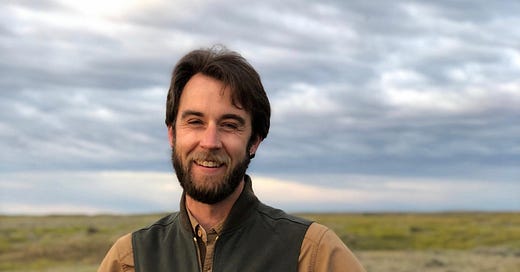



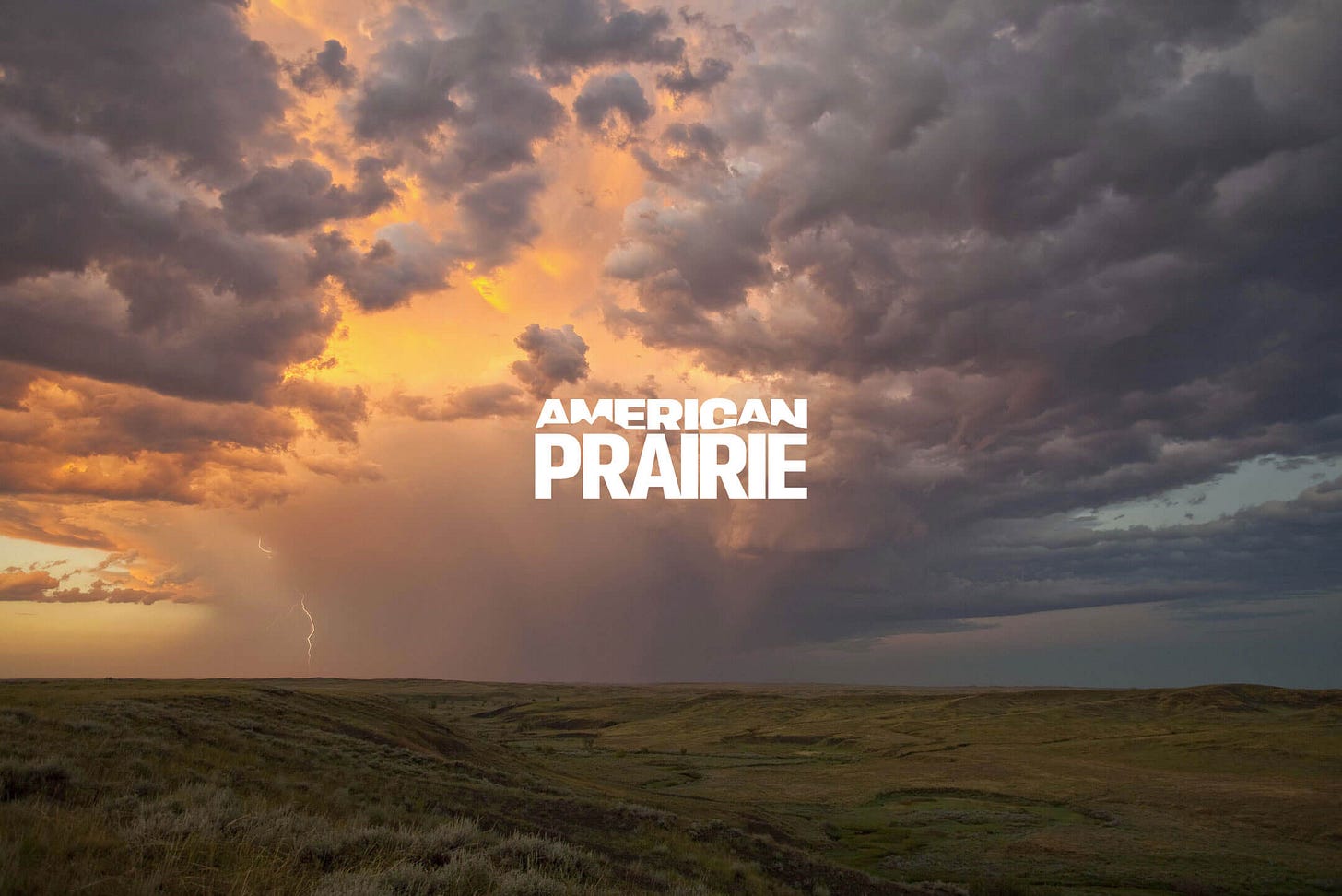
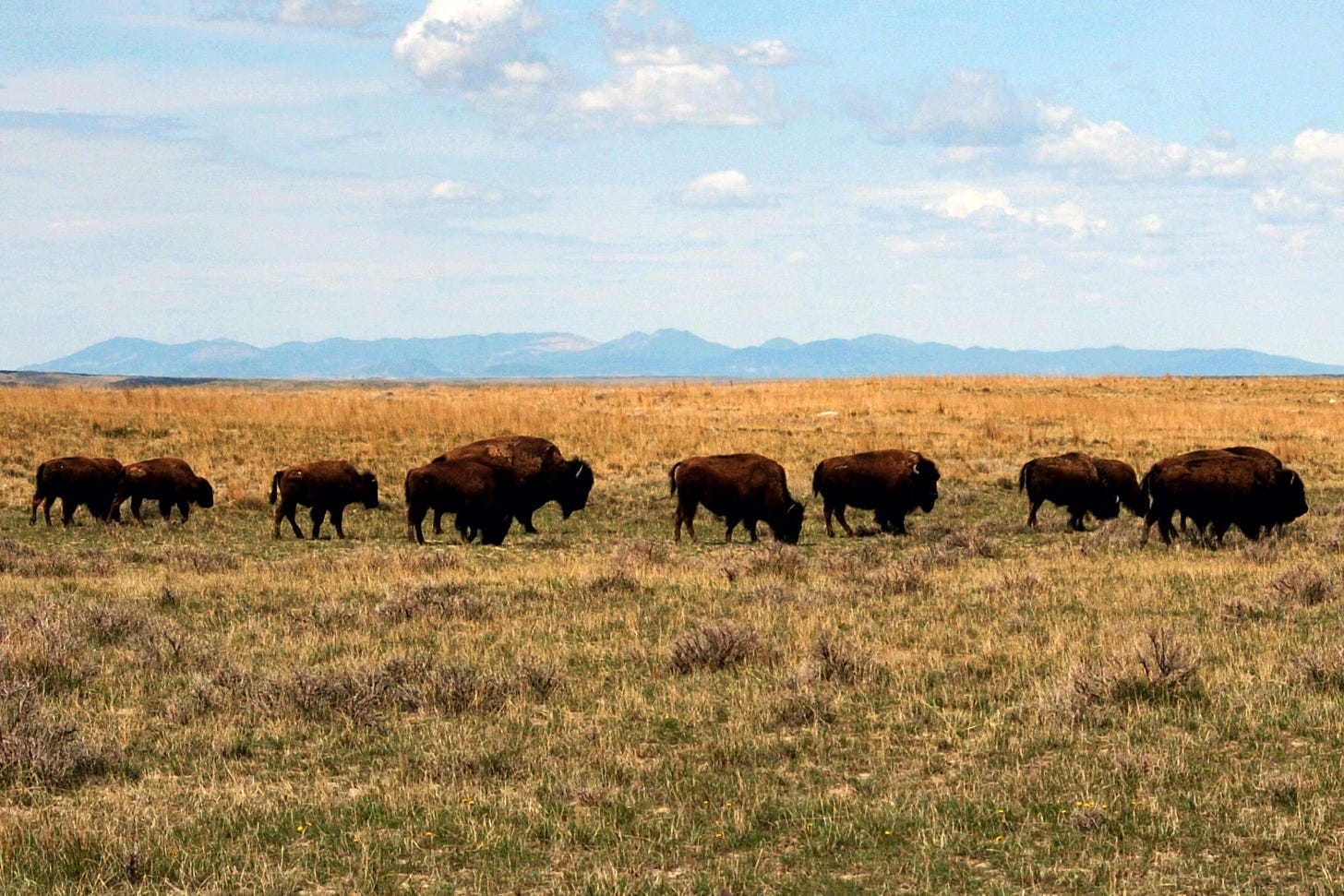
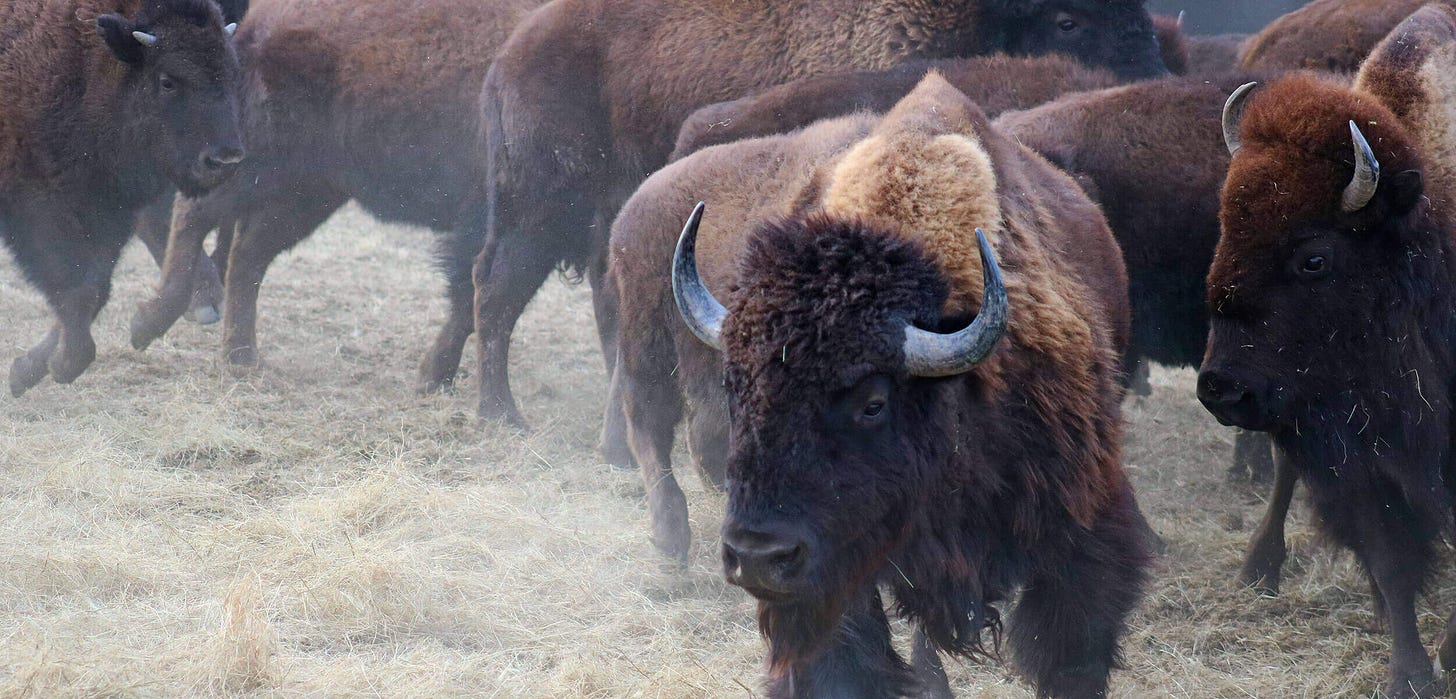

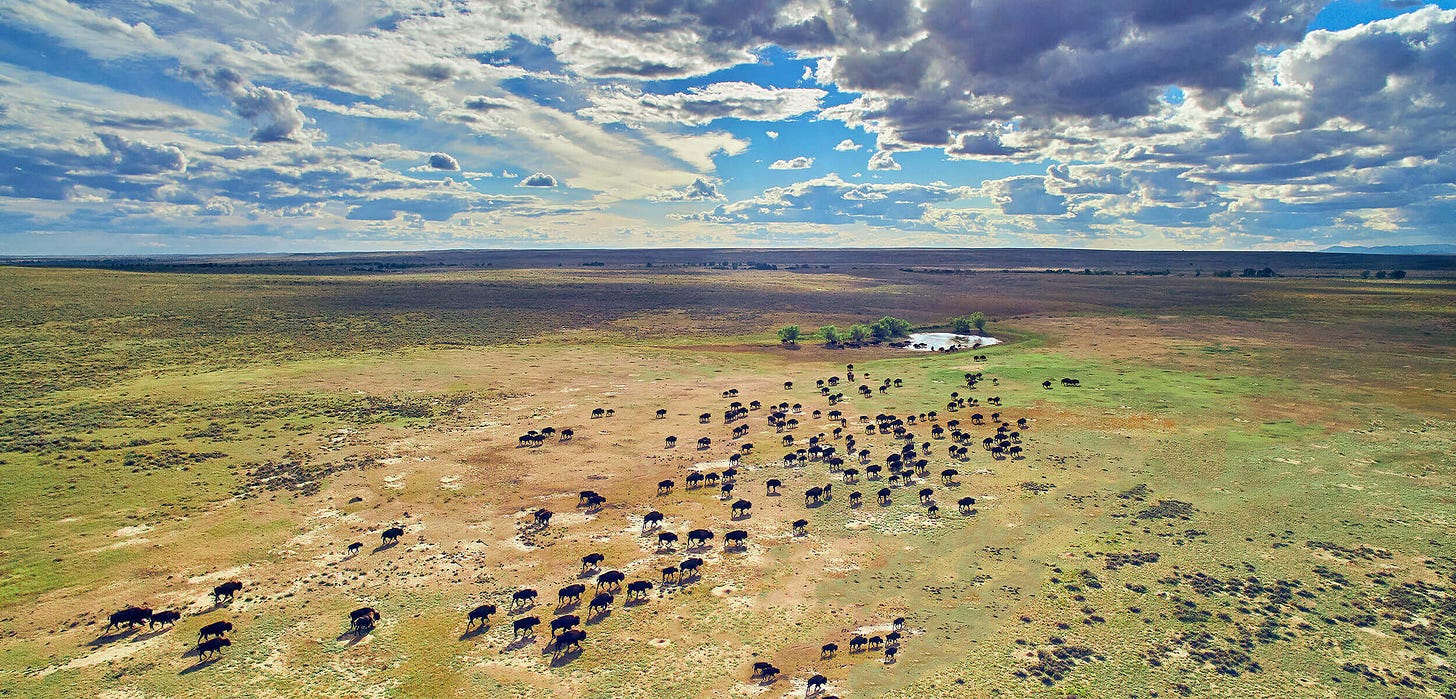


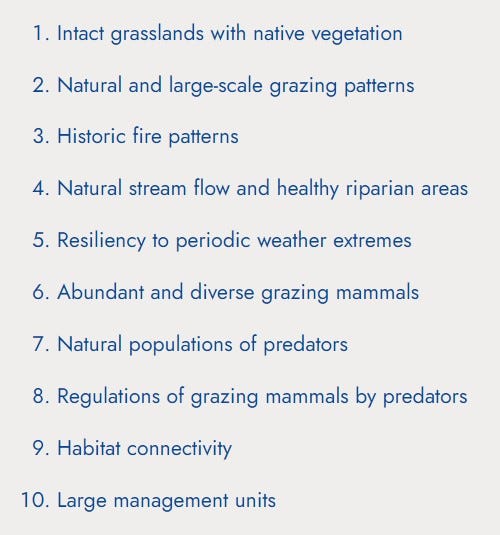
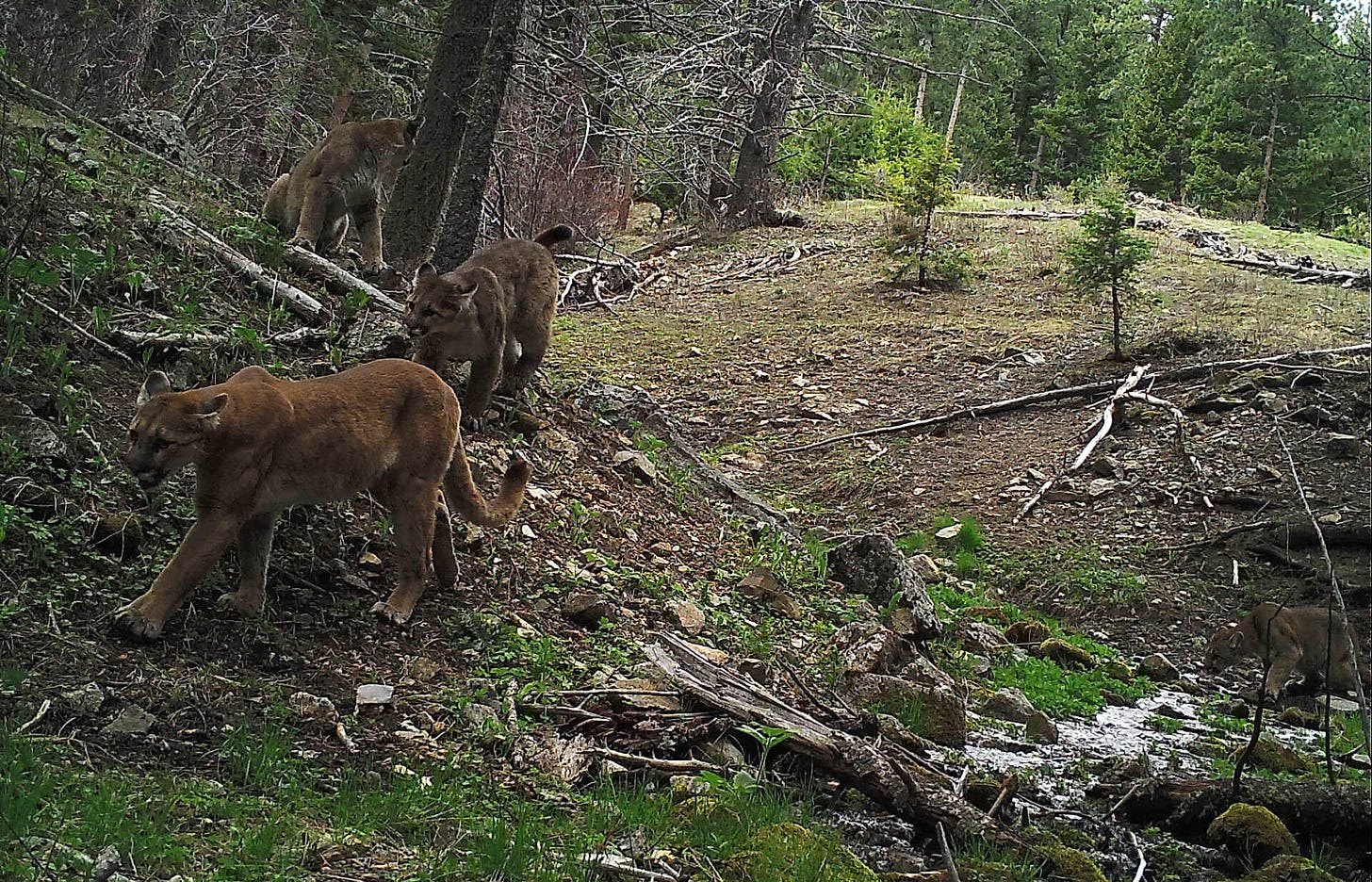

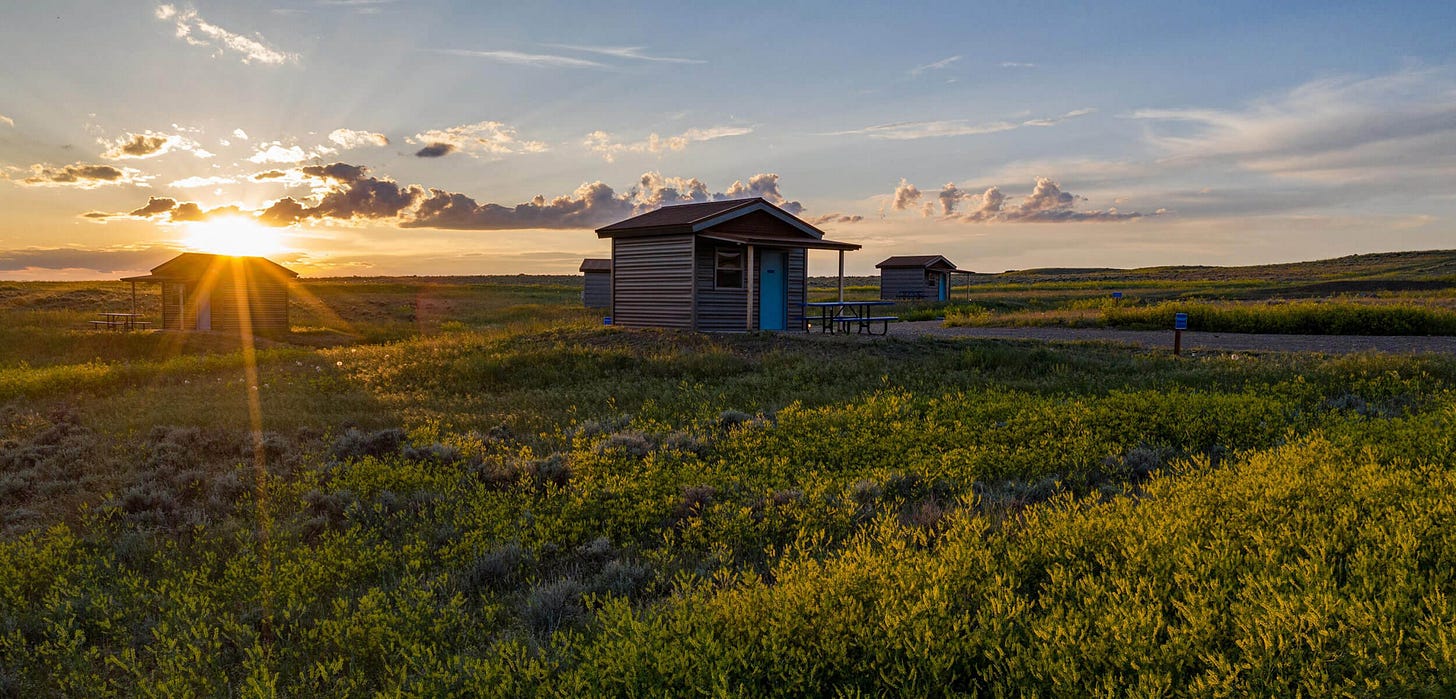
A fascinating interview. It's not an environment I know much about, so it was great to hear about things like the role of bison.
Another great interview. You could compile a really great book from all of these you have conducted. I really love the short grass prairie, having grown up on it, having family properyiesy on it, dreaming of living on it. Love this scientists work. Suggest his group look at the NE Colorado's Pawnee National Grasslands area and the Sandhills area in western Nebraska for prime areas of acquisitions. Island biogeography is what they're dealing with and to make it work they're going to deal with a host of issues. Don't play favorites with the species. The fleas the plagues are part of life out there! Don't try to recreate a prairie of 150 years ago..that can't work. Just deal with what's there now! Nature has made adjustments and there's kind of a rolling equilibrium, including feral dogs rather than wolves, cattle rather than bison, etc. Reintroducing grizzlies!? Bad idea! Live in Deep Time and see this amazing prairie for what it is- a community of life far older than the dinosaurs, with ever changing dwellers..don't try to freeze a past variant of it! Just let it be and keep the humans out of it!